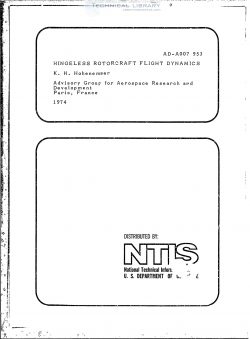AGARD-AG-197
- Version
- 369 Downloads
- 4.71 MB File Size
- 1 File Count
- March 1, 2017 Create Date
- March 1, 2017 Last Updated
Hingeless Rotorcraft Flight Dynamics

During the last decade, hingeless rotorcraft has been the subject of substantial research, development, and testing, because of their reduced maintenance, unpowered performance, and better flying qualities. Production of hingeless rotorcraft is now under way. Experience has shown that. compared to articulated rotors, hingeless rotors are more demanding With respect to the dynamic design. Structural Integrity, good handling qualities, and flight stability depend on a proper assessment Of the dynamics problem, much more so than for articulated rotorcraft. This report reviews recent work on the fight dynamics Of hingeless rotorcraft, with emphasis on concepts rather than on details The usual diVISlon of aircraft dynamics Into rigid body flight dynamics and structural dynamics that Include vibrations and aero, elasticity, 'S not applicable for rotorcraft, especially hingeless rotorcraft. Elastic blade deformations greatly affect handling qualities and must be Included In a discussion of hingeless rotorcraft flight dynamics. Here, a somewhat arbitrary line IS drawn b•tween flight dynamics and structural dynamics. Phenomena that involve blade torsional modes leading to potential classical flutter and phenomena that Involve the higher blade bending modes and elastic fuselage modes essential for the vibration characteristics Of the rotorcraft are relegated to structural dynamics. Phenomena that Involve the lower blade flap and lag bending modes - Including blade torsional elastic deflections, but excluding torsion dynamics — and the rigid-body modes are relegated to flight dynamics. This division assumes that blade torsional natural frequencies are sever-I times greater than the rotor rotational frequency, which IS true of current lifting rotors According to the dividing, i•ne drawn here, resonance phenomena and other low-frequency Instabilities In flight belong to flight dynamics and are included here. Although of great Importance for the overall design, material selection and their properties are not considered here Only "fling rotors are considered, omitting the Epec.al problems of h.ngeless tilting prop/rotor aircraft. Of the various feedback control systems, only those for the Inner loop are considered s.nce they can strongly couple with the elastic rotor modes. This survey report 's not directed primarily to the dynamics specialist but rather to the rotorcraft design engineer who wishes to be introduced to the flight-dynamics problems of hingeless rotorcraft and to the methods for their solutions known to date. Chapters 1 to 6 are almost purely dexr.pt.ve with a few Simple equations in chapter 4 that define several blade coupling parameters and, In chapter 6, that define several feedback parameters. Chapters 7 and 8, m addition to descriptive material, also contains mathematical formulations of the basic methods discussed. Most of the literature is Cited in chapter 2, on the history of hingeless rotorcraft. In Inverse chronological order within each section. The reference list has an appendix containing relevant recent publications not Cited in the text.
| File | Action |
|---|---|
| AGARD-AG-197 Hingeless Rotorcraft Flight Dynamics.pdf | Download |

Comment On This Post